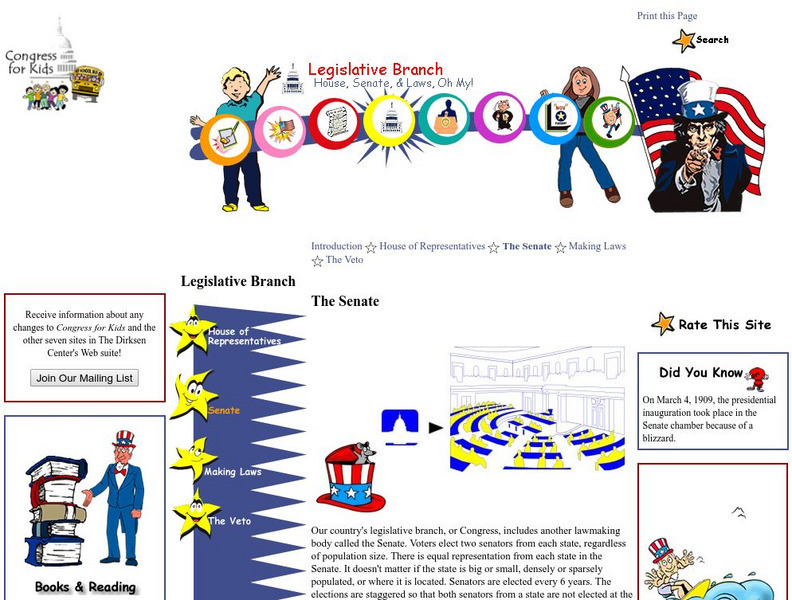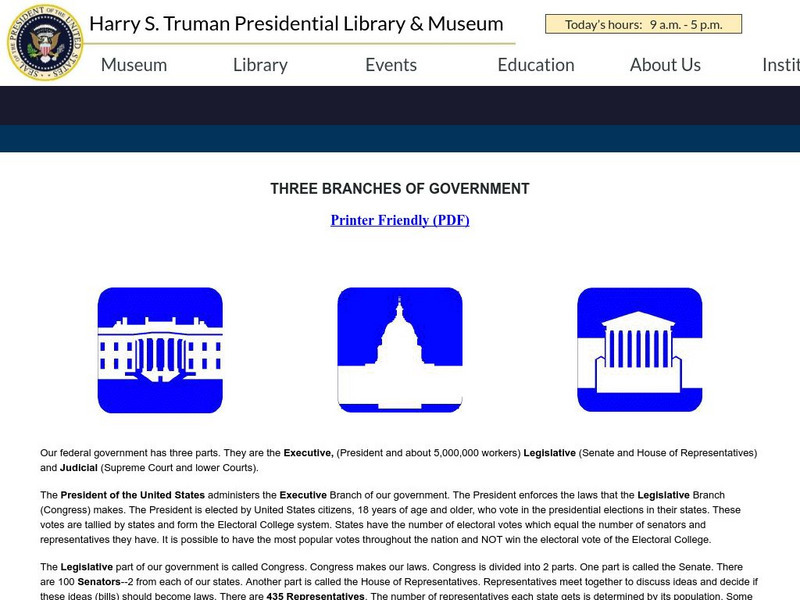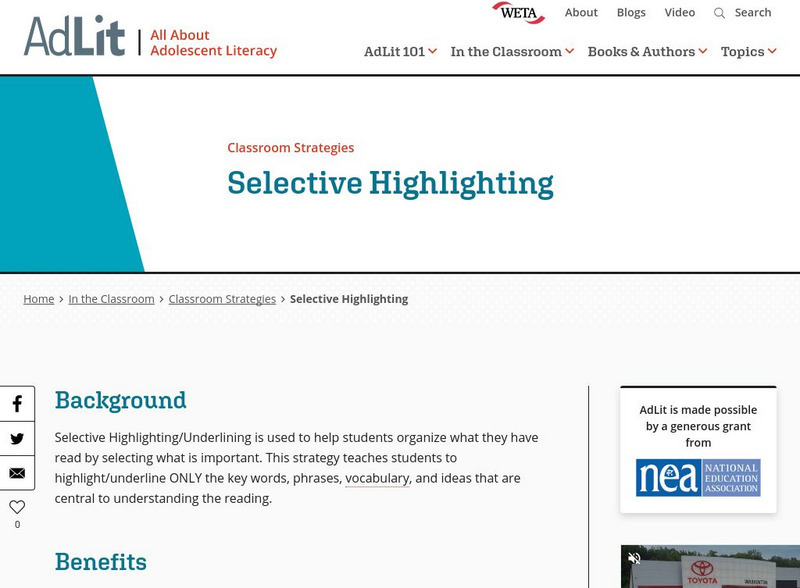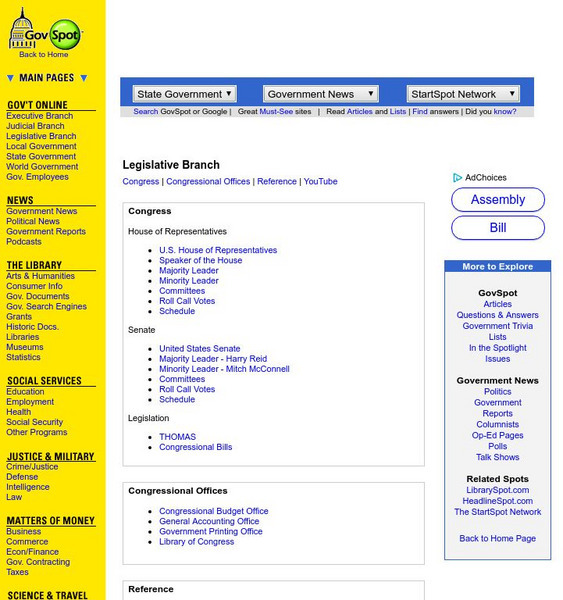iCivics
I Civics: Three Branches: Laws in Action
Embark on his WebQuest to follow the path an idea takes to eventually become a law. Read a short description regarding the role of each branch of government and then answer a follow-up question using the link provided.
Other
Learning Farm: Compare and Contrast Informational Texts
In this narrated tutorial, students are presented with information about first and third points of view, then read two passages about the same event and answer questions that compare how the topic is presented. After completing the...
US Government Publishing Office
Ben's Guide to u.s. Government: Learning Adventures: Branches of Government
Introduction to a learning adventure on the Constitution and branches of government. Students click on their age group icon to find information on which part of the Constitution spells out the powers of legislative, executive and...
US Government Publishing Office
Ben's Guide to u.s. Government: Judicial Branch (6 8)
This site from Ben's Guide to U.S. Government provides a brief overview of the judicial branch of the federal government. Discusses the origin of the judicial branch, the concept of judicial review, and functions of the judicial branch....
The Dirksen Congressional Center
Congress for Kids: Legislative Branch, the Senate
Activities that students can use to understand the job of the US Senate, and become more engaged in the legislative process.
The Dirksen Congressional Center
Congress for Kids: The Legislative Branch: Making Laws
Discover how laws are made in the United States, and then complete the trivia questions as a follow-up activity.
The Dirksen Congressional Center
Congress for Kids: The Legislative Branch: House of Representatives
Read a brief synopsis of the House of Representatives in the Legislative Branch, and then complete the short quiz to check for understanding.
Harry S. Truman Library and Museum
Harry S. Truman Library & Museum: Three Branches of Our Government
This slide and the six that follow it (use the advance button near the bottom of the screen) offer an explanation of each of the three branches of government and the duties they perform, including discussion of the tensions arising from...
CommonLit
Common Lit: Text Sets
This is a collection of 35 Grade-Leveled text sets (4-11). They are great for social studies teachers or for building background knowledge in reading class, CommonLit's text sets cover a range of historical, cultural, and political...
US Government Publishing Office
Ben's Guide to u.s. Government: The Senate
Information about the qualifications and duties of the United States Senate.
Library of Congress
Loc: American History Through Congressional Documents: 1774 1873
Timeline of American history as seen in Congressional documents, 1774-1873.
PBS
Pbs: Passing a Bill Through Congress
Student handout provides the steps for how to pass a bill through Congress.
Online Writing Lab at Purdue University
Purdue University Owl: Primary Research
Learn the difference between primary and secondary research as well as some different types of primary sources that can be used when gathering research.
Alabama Learning Exchange
Alex: It's in the Hopper!
A Congressional simulation in which students research a topic of interest, write a bill, and submit the bill for consideration by a Congressional committee of their peers. This lesson teaches in a real way the legislative process and...
Alabama Learning Exchange
Alex: "I'm Just a Bill"
Students will examine current and recently introduced Congressional legislation using the Thomas search engine. After reading legislation, students will write and post their proposed legislation for peer editing and comment. This lesson...
Alabama Learning Exchange
Alex: Where Can I Find That Book?
This lesson allows students to use current topics of study (e.g. the Stamp Act, the Boston Tea Party, the Intolerable Acts) to learn about the Library of Congress Classification System (LCC).
Alabama Learning Exchange
Alex: How to Cite Online Resources
After research in the Alabama Virtual Library, students will write a paragraph essay and use an online citation utility to create bibliographic citations for an online encyclopedia, an online magazine, and a print resource. Copying and...
Social Studies for Kids
Social Studies for Kids: How a Bill Becomes a Law
Follow a bill, from its introduction to Congress to its signing by the President. Find out about all the steps in between, including the presidential veto and the Congressional override.
Khan Academy
Khan Academy: Approaches to Knowledge
An article addressing how knowledge is acquired from different media formats. The article also discusses how scholars from the past asked questions about knowledge and launched their own investigations.
AdLit
Ad lit.org: Classroom Strategies: Selective Highlighting
Selective Highlighting/Underlining is used to help students organize what they have read by selecting what is important. This strategy teaches students to highlight/underline ONLY the key words, phrases, vocabulary, and ideas that are...
AdLit
Ad lit.org: Literacy Instruction in the Content Areas: The Core of Improvement
Every content area, from chemistry to history, has unique literacy demands: texts, knowledge, skills. But how are these critical literacies learned, let alone taught?
Other
Govspot: Legislative Branch
This site has an outline from Govspot of the Legislative Branch of the United States. This site links you to every part of the Judicial Branch of the United States.
US Government Publishing Office
Ben's Guide to u.s. Government: Judicial Branch (9 12)
Provides a brief overview of the judicial branch of the federal government. Discusses the origin of the judicial branch, the concept of judicial review, and functions of the judicial branch. Links to more information about the U.S....
Ducksters
Ducksters: Us Government for Kids: Legislative Branch Congress
Kids learn about the Legislative Branch of the United States Government. It's also called the Congress and is made up of the House of Representatives and the Senate.




















